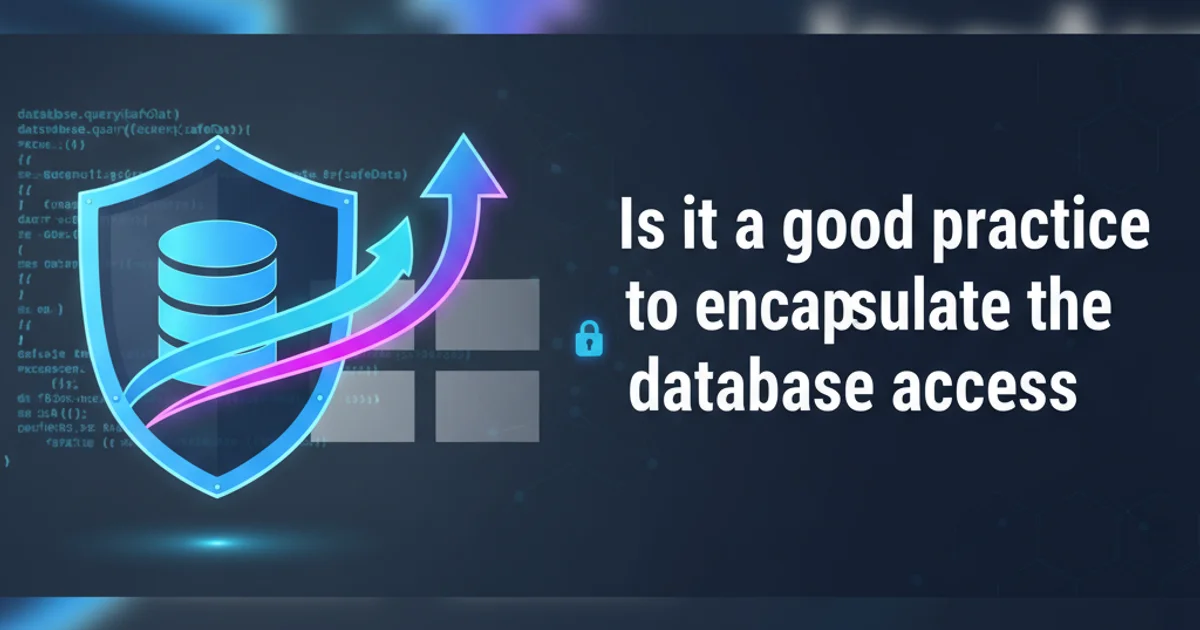Is it a good practice to encapsulate the database access
Categories:
The Art of Encapsulation: Best Practices for Database Access

Explore why encapsulating database access is a fundamental practice for building robust, maintainable, and scalable applications. Learn about common patterns and their benefits.
In software development, managing data persistence is a critical aspect of almost every application. Directly interacting with a database throughout your codebase can quickly lead to tightly coupled, hard-to-maintain, and insecure systems. This article delves into the concept of encapsulating database access, explaining its benefits and demonstrating practical approaches to achieve it, regardless of your chosen programming language or database technology.
Why Encapsulate Database Access?
Encapsulation, a core principle of object-oriented programming, involves bundling data and methods that operate on the data within a single unit, and restricting direct access to some of the component's internal state. When applied to database access, it means abstracting away the details of how data is stored and retrieved. This practice offers several significant advantages:
flowchart TD
A[Application Layer] --> B{Data Access Layer (DAL)}
B --> C[Database]
C --"SQL Queries"--> B
B --"Mapped Objects"--> A
subgraph Benefits
D["Reduced Coupling"]
E["Easier Testing"]
F["Improved Security"]
G["Database Agnostic Potential"]
H["Centralized Logic"]
end
B --- D
B --- E
B --- F
B --- G
B --- HFlowchart illustrating the role of a Data Access Layer (DAL) and its benefits.
Common Encapsulation Patterns
Several well-established patterns facilitate effective database access encapsulation. The choice often depends on the project's complexity, team preferences, and the specific technologies being used.
1. Repository Pattern
The Repository pattern mediates between the domain and data mapping layers, acting like an in-memory collection of domain objects. It provides methods for adding, removing, and querying objects, abstracting the underlying data storage mechanism. This makes your application's business logic independent of the data access technology.
public interface IUserRepository
{
User GetById(int id);
IEnumerable<User> GetAll();
void Add(User user);
void Update(User user);
void Delete(int id);
}
public class UserRepository : IUserRepository
{
private readonly DbContext _context;
public UserRepository(DbContext context)
{
_context = context;
}
public User GetById(int id) => _context.Users.Find(id);
public IEnumerable<User> GetAll() => _context.Users.ToList();
public void Add(User user) => _context.Users.Add(user);
public void Update(User user) => _context.Users.Update(user);
public void Delete(int id)
{
var user = _context.Users.Find(id);
if (user != null) _context.Users.Remove(user);
}
}
Example of a simple Repository pattern implementation in C#.
2. Data Access Object (DAO) Pattern
The DAO pattern separates a data persistence mechanism from the rest of the application. It provides an abstract interface to a database or other persistence mechanism, allowing the application to interact with data without knowing the specifics of the database. DAOs are typically more focused on CRUD (Create, Read, Update, Delete) operations for specific entities.
Java
public interface UserDao {
User getUser(long id);
List
public class UserDaoImpl implements UserDao { // JDBC or ORM specific implementation @Override public User getUser(long id) { // ... database query logic ... return new User(id, "John Doe"); } // ... other method implementations ... }
Python
class UserDAO: def get_user(self, user_id): # Database query logic (e.g., using SQLAlchemy or raw SQL) print(f"Fetching user with ID: {user_id} from DB") return {'id': user_id, 'name': 'Jane Doe'}
def create_user(self, user_data):
# Database insert logic
print(f"Creating user: {user_data} in DB")
return {'id': 1, **user_data}
Implementing Encapsulation: Practical Steps
To effectively encapsulate your database access, consider the following steps:
1. Define Clear Interfaces
Start by defining interfaces for your data access operations. This promotes loose coupling and allows for easy swapping of implementations (e.g., for testing with mock data or changing database technologies).
2. Separate Concerns
Ensure your data access logic resides in its own dedicated layer, separate from business logic, UI, or API endpoints. This separation is key to maintainability.
3. Use Dependency Injection
Inject your data access dependencies (like repositories or DAOs) into your business logic components. This makes your code more testable and flexible.
4. Handle Exceptions Gracefully
Implement robust error handling within your data access layer. Catch database-specific exceptions and translate them into more generic, application-level exceptions that your business logic can understand and handle.